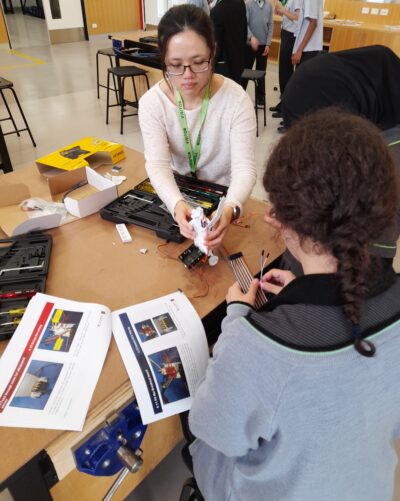By Rachel Ella
“The year is 2030 and an international group of Astronauts has just landed on Mars. To support health and wellbeing on this long-term mission tasty, fresh plants are grown in carefully monitored Space labs. Astronauts carefully monitor resource supply and demand for sustainable production. A meteorite storm requires the plant-bot to pick and deliver the food to astronauts, but can it make it through the Mars terrain unscathed?” – Associate Professor Kim Johnson, La Trobe University lecturer and Plants for Space researcher.
The next 20 years will prove to be an exciting time for Space and Agricultural scientists alike as crewed missions to the moon and Mars take off. Supplying varied and nutritious food to crews on the three-year round trip to Mars is one of the challenges faced. Plants will need to be grown, on Mars, to maintain the physical and mental health of the crew. Yes, that’s right! Plants grown on Mars!
The problem: there is a severe skills shortage in Australia in both the Space and Agriculture industries to make this a reality.
The solution: introduce the topic to early secondary school students and inspire them to become part of the first mission to Mars! A collaboration between In2science, Greenvale Secondary College in Victoria, St Helens District High School in Tasmania, the Victorian Space Science Education Centre (VSSEC), and led by the La Trobe Institute of Sustainable Agriculture and Food (LISAF) did just that.
 Students from grade 6 to year 8 were tasked with growing duckweed and building robots. Greenvale SC had the assistance of our mentor Lim Chee Liew who is a Research Fellow at LISAF. Lim Chee assisted the students in preparing agar plates to grow the duckweed, which was then placed in environments of varying light levels. Lim Chee demonstrated how to use a light meter to measure light intensity, and over the following weeks data was collected to measure and compare the growth of the plants.
Students from grade 6 to year 8 were tasked with growing duckweed and building robots. Greenvale SC had the assistance of our mentor Lim Chee Liew who is a Research Fellow at LISAF. Lim Chee assisted the students in preparing agar plates to grow the duckweed, which was then placed in environments of varying light levels. Lim Chee demonstrated how to use a light meter to measure light intensity, and over the following weeks data was collected to measure and compare the growth of the plants.
“What is duckweed?” I hear you ask. Duckweed is the world’s smallest flowering plant, common in freshwater habitats and is a rich source of nutrients. When we think of plant-based protein we think of soy and wheat, but as these are among the top foods that cause allergies, research is being done to find alternatives. Duckweed is one such alternative, with protein levels reaching a massive 41%! It has the added benefit of high levels of minerals and vitamins – up to 26%. Another benefit of duckweed is its simple structure allowing for rapid growth, taking a mere 3.5 to 6.5 days to double in size! I am sure you will agree that all these elements make duckweed a very attractive food source for our astronauts.
Next was the robot build. The robot kits were sourced by Simon Egerton, Deputy Head of the Department of Computer Science & Information Technology at La Trobe. In small groups, and with the assistance of Lim Chee, the students built their robots following a detailed instruction manual and accompanying videos created by Simon. The students also drew a plan of their proposed Martian gardens, both in greenhouses and outdoors, taking into consideration the different surface environment as compared to Earth. There was also a requirement for the robots to have an implement to harvest the duckweed and transport it from the gardens to the astronauts’ living quarters, which the students designed and constructed.
 The project concluded in mid-December with a student showcase held at La Trobe University’s AgriBio facility with the students in Tasmania connected via live stream. We heard from recently retired NASA Crop Production Engineer Ralph Fritsche, who spoke about his time at NASA, the future of space exploration and habitation, and the need for a ready supply of fresh nutritious foods to be available to astronauts. This was fascinating! Each group of students then presented their garden plan and robot with its accompanying harvesting/transport prototype. The students described their motivation behind their designs and talked about their robot build – what they enjoyed and what they found challenging. Both schools presented their results on the growth of their duckweed and showed that the duckweed grew faster with more sunlight but that meant that it also required more water. It was suggested that in future a controlled UV light/hydroponics system could be used to maximise the growth of the duckweed.
The project concluded in mid-December with a student showcase held at La Trobe University’s AgriBio facility with the students in Tasmania connected via live stream. We heard from recently retired NASA Crop Production Engineer Ralph Fritsche, who spoke about his time at NASA, the future of space exploration and habitation, and the need for a ready supply of fresh nutritious foods to be available to astronauts. This was fascinating! Each group of students then presented their garden plan and robot with its accompanying harvesting/transport prototype. The students described their motivation behind their designs and talked about their robot build – what they enjoyed and what they found challenging. Both schools presented their results on the growth of their duckweed and showed that the duckweed grew faster with more sunlight but that meant that it also required more water. It was suggested that in future a controlled UV light/hydroponics system could be used to maximise the growth of the duckweed.
This pilot project has been a great success, with overall positive feedback provided from the teachers, students, and mentors. Congratulations to everyone involved! If you would like to be part of the In2science program and Plant Life on Mars, please get in touch and help us to inspire the next generation of STEM champions!


